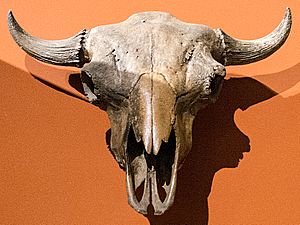Late Pleistocene facts for kids
The Late Pleistocene (say: PLAY-stuh-seen) is a time period in Earth's history. It's like a chapter in our planet's very long story. This period lasted from about 129,000 years ago to about 11,700 years ago. It's also sometimes called the Upper Pleistocene. This time is important because it was when the last big ice age happened.
During the Late Pleistocene, huge sheets of ice covered large parts of the Earth. Many very large animals, called megafauna, like mammoths, lived then. Sadly, many of these animals later became extinct. This period also saw important stages in human development, including when early humans moved to different parts of the world. It was also when the last types of ancient humans disappeared.
Contents
When Was the Last Ice Age?
The Late Pleistocene began around 126,000 years ago. This was when a period of warming, called the Eemian interglacial period, started. An interglacial period is a warmer time between two ice ages.
This warmer period ended about 115,000 years ago. That's when the Last Glacial Period (LGP) began. This is what we often call the Last Ice Age. In Europe, it's known by names like the Würm glaciation or Weichselian glaciation. In North America, it's called the Wisconsin glaciation.
How Far Did the Ice Spread?
The coldest part of the Last Ice Age was between 26,000 and 19,000 years ago. During this time, huge ice sheets covered much of Northern Europe, including most of Great Britain. They also reached the Great Lakes in North America.
Because so much water was frozen in ice, sea levels dropped a lot. This created land bridges that connected continents. Two important land bridges were:
- Doggerland: This connected Great Britain to mainland Europe.
- Bering land bridge: This joined Alaska to Siberia. These land bridges were very important for early human migrations.
What Happened After the Ice Age?
After the coldest part, the Earth started to warm up again. This warming period was called the Late Glacial Interstadial. But then, there was a sudden return to very cold, icy conditions called the Younger Dryas. This cold snap lasted until about 11,700 years ago.
The end of the Younger Dryas marks the official end of the Pleistocene Epoch and the beginning of our current time, the Holocene Epoch. During the entire Late Pleistocene, humans were still in the Palaeolithic (Old Stone) Age. They used basic stone and wooden tools. Many people were nomadic tribes, meaning they moved around, often following animal herds. Others were hunter-gatherers, finding food by gathering plants and hunting animals.
Human Life Around the World
Africa
In Egypt, the Late Palaeolithic period started after 30,000 BC. People in North Africa moved to the Nile Valley because the Sahara region changed from a grassy area to a desert. Scientists found a human skeleton in Egypt, called the Nazlet Khater skeleton, which is about 30,000 to 35,000 years old.
Eurasia
Neanderthals (Homo neanderthalensis) lived in Europe and Asia until they died out between 40,000 and 30,000 years ago. Towards the end of the Late Pleistocene, many large mammals like the woolly rhinoceros, mammoth, and Irish elk also became extinct.
Early humans created amazing cave paintings. Some of the most famous ones are at Lascaux in France, which might be over 17,000 years old. These paintings mostly show animals like buffalo and deer that people hunted. Other famous cave paintings are found at Altamira in Spain, and in India, Australia, and the Sahara.
The Magdalenian people were hunter-gatherers who lived across western Europe about 18,000 years ago. They were very clever and invented the first known harpoons, which they made from reindeer horn.
The only animal that humans had domesticated during the Pleistocene was the dog. Dogs evolved from grey wolves. It's thought that grey wolves started to live with hunter-gatherer tribes around 15,000 years ago. The oldest remains of a true domestic dog are about 14,200 years old. Other animals like cattle, goats, pigs, and sheep were not domesticated until the Holocene, when people started to settle down and farm.
Far East
The first signs of humans living in Japan go back to between 40,000 BC and 30,000 BC. The oldest human fossils found there are about 35,000 years old. At that time, Japan was not connected to mainland Asia by land bridges. The main islands of Japan, like Hokkaido and Honshu, were also separate from each other.
North America

Around 28,000 years ago, people started to cross the Bering land bridge from Siberia to Alaska. These people became the Native Americans. It's believed that these first tribes later moved south into Central and South America.
In North America, large bison species like Bison occidentalis and Bison antiquus lived during the Late Pleistocene. These were bigger than today's bison. The Clovis people, who were early Native Americans, hunted these bison for food.
Oceania
There is evidence that humans lived in mainland Australia, Indonesia, New Guinea, and Tasmania from about 45,000 BC. This evidence includes rock carvings, stone tools, and signs that people lived in caves.
|
See also
 In Spanish: Tarantiense para niños
In Spanish: Tarantiense para niños


